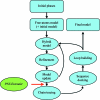Use of noncrystallographic symmetry for automated model building at medium to low resolution
- PMID: 22505265
- PMCID: PMC3322604
- DOI: 10.1107/S0907444911050712
Use of noncrystallographic symmetry for automated model building at medium to low resolution
Abstract
A novel method is presented for the automatic detection of noncrystallographic symmetry (NCS) in macromolecular crystal structure determination which does not require the derivation of molecular masks or the segmentation of density. It was found that throughout structure determination the NCS-related parts may be differently pronounced in the electron density. This often results in the modelling of molecular fragments of variable length and accuracy, especially during automated model-building procedures. These fragments were used to identify NCS relations in order to aid automated model building and refinement. In a number of test cases higher completeness and greater accuracy of the obtained structures were achieved, specifically at a crystallographic resolution of 2.3 Å or poorer. In the best case, the method allowed the building of up to 15% more residues automatically and a tripling of the average length of the built fragments.
Figures







Similar articles
-
Flexible torsion-angle noncrystallographic symmetry restraints for improved macromolecular structure refinement.Acta Crystallogr D Biol Crystallogr. 2014 May;70(Pt 5):1346-56. doi: 10.1107/S1399004714003277. Epub 2014 Apr 30. Acta Crystallogr D Biol Crystallogr. 2014. PMID: 24816103 Free PMC article.
-
Automated structure solution with the PHENIX suite.Methods Mol Biol. 2008;426:419-35. doi: 10.1007/978-1-60327-058-8_28. Methods Mol Biol. 2008. PMID: 18542881
-
On the validation of crystallographic symmetry and the quality of structures.Protein Sci. 2015 May;24(5):621-32. doi: 10.1002/pro.2595. Epub 2014 Dec 9. Protein Sci. 2015. PMID: 25352397 Free PMC article.
-
Current state of automated crystallographic data analysis.Nat Struct Biol. 2000 Nov;7 Suppl:978-81. doi: 10.1038/80763. Nat Struct Biol. 2000. PMID: 11104005 Review.
-
Carbohydrate structure: the rocky road to automation.Curr Opin Struct Biol. 2017 Jun;44:39-47. doi: 10.1016/j.sbi.2016.11.011. Epub 2016 Dec 9. Curr Opin Struct Biol. 2017. PMID: 27940408 Review.
Cited by
-
Visual automated macromolecular model building.Acta Crystallogr D Biol Crystallogr. 2013 Apr;69(Pt 4):635-41. doi: 10.1107/S0907444913000565. Epub 2013 Mar 14. Acta Crystallogr D Biol Crystallogr. 2013. PMID: 23519672 Free PMC article.
-
Design and directed evolution of noncanonical β-stereoselective metalloglycosidases.Nat Commun. 2022 Nov 11;13(1):6844. doi: 10.1038/s41467-022-34713-8. Nat Commun. 2022. PMID: 36369431 Free PMC article.
References
Publication types
MeSH terms
Substances
LinkOut - more resources
Full Text Sources

